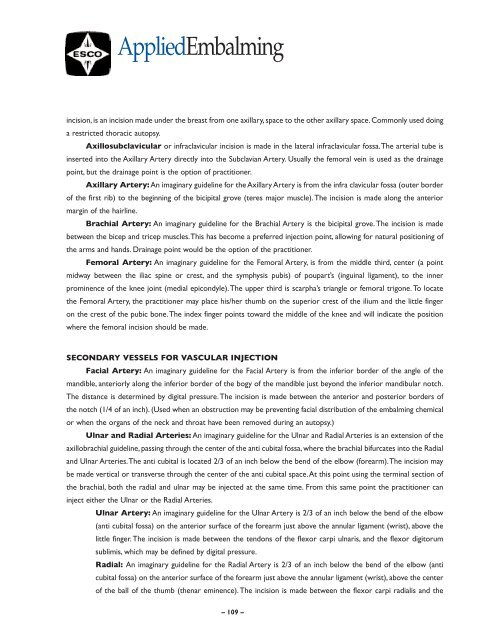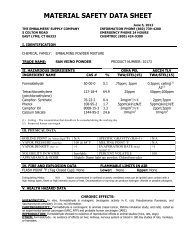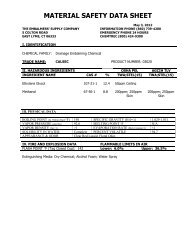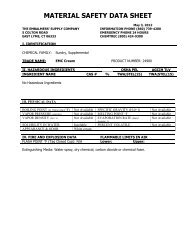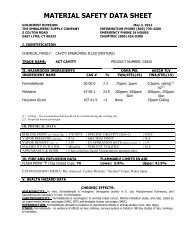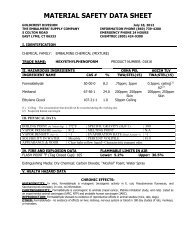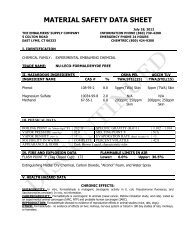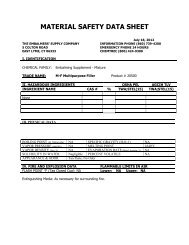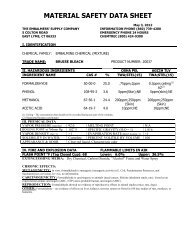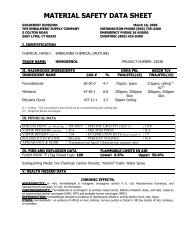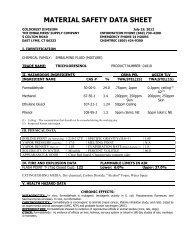Executive Offices - Embalming Supply Company
Executive Offices - Embalming Supply Company
Executive Offices - Embalming Supply Company
Create successful ePaper yourself
Turn your PDF publications into a flip-book with our unique Google optimized e-Paper software.
Applied<strong>Embalming</strong><br />
incision, is an incision made under the breast from one axillary, space to the other axillary space. Commonly used doing<br />
a restricted thoracic autopsy.<br />
axillosubclavicular or infraclavicular incision is made in the lateral infraclavicular fossa. The arterial tube is<br />
inserted into the Axillary Artery directly into the Subclavian Artery. Usually the femoral vein is used as the drainage<br />
point, but the drainage point is the option of practitioner.<br />
axillary artery: An imaginary guideline for the Axillary Artery is from the infra clavicular fossa (outer border<br />
of the first rib) to the beginning of the bicipital grove (teres major muscle). The incision is made along the anterior<br />
margin of the hairline.<br />
Brachial artery: An imaginary guideline for the Brachial Artery is the bicipital grove. The incision is made<br />
between the bicep and tricep muscles. This has become a preferred injection point, allowing for natural positioning of<br />
the arms and hands. Drainage point would be the option of the practitioner.<br />
femoral artery: An imaginary guideline for the Femoral Artery, is from the middle third, center (a point<br />
midway between the iliac spine or crest, and the symphysis pubis) of poupart’s (inguinal ligament), to the inner<br />
prominence of the knee joint (medial epicondyle). The upper third is scarpha’s triangle or femoral trigone. To locate<br />
the Femoral Artery, the practitioner may place his/her thumb on the superior crest of the ilium and the little finger<br />
on the crest of the pubic bone. The index finger points toward the middle of the knee and will indicate the position<br />
where the femoral incision should be made.<br />
SeCOndary VeSSelS fOr VaSCular injeCTiOn<br />
facial artery: An imaginary guideline for the Facial Artery is from the inferior border of the angle of the<br />
mandible, anteriorly along the inferior border of the bogy of the mandible just beyond the inferior mandibular notch.<br />
The distance is determined by digital pressure. The incision is made between the anterior and posterior borders of<br />
the notch (1/4 of an inch). (Used when an obstruction may be preventing facial distribution of the embalming chemical<br />
or when the organs of the neck and throat have been removed during an autopsy.)<br />
ulnar and radial arteries: An imaginary guideline for the Ulnar and Radial Arteries is an extension of the<br />
axillobrachial guideline, passing through the center of the anti cubital fossa, where the brachial bifurcates into the Radial<br />
and Ulnar Arteries. The anti cubital is located 2/3 of an inch below the bend of the elbow (forearm). The incision may<br />
be made vertical or transverse through the center of the anti cubital space. At this point using the terminal section of<br />
the brachial, both the radial and ulnar may be injected at the same time. From this same point the practitioner can<br />
inject either the Ulnar or the Radial Arteries.<br />
ulnar artery: An imaginary guideline for the Ulnar Artery is 2/3 of an inch below the bend of the elbow<br />
(anti cubital fossa) on the anterior surface of the forearm just above the annular ligament (wrist), above the<br />
little finger. The incision is made between the tendons of the flexor carpi ulnaris, and the flexor digitorum<br />
sublimis, which may be defined by digital pressure.<br />
radial: An imaginary guideline for the Radial Artery is 2/3 of an inch below the bend of the elbow (anti<br />
cubital fossa) on the anterior surface of the forearm just above the annular ligament (wrist), above the center<br />
of the ball of the thumb (thenar eminence). The incision is made between the flexor carpi radialis and the<br />
– 109 –


